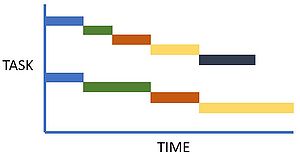Overcoming small-big projects (Gantt)
Contents |
Abstract
Overcoming small to big projects, a simple way to managing a project is with the tool, Gantt also called Bart Chart, which helps a project managers to execute a single project or multiple project at one place. A Gantt Chart consists of an activity list or a WBS given against important dates, which gives a duration of how long a project will be held. There are five steps to in order to create or prepare for a Gantt Chart and this article will take you through more about what a Gantt Chart is used for, who can be involved, how to create a Gantt and benefits and complications about using one.
What is a Gantt
A simple way to managing a project whether it is complex or not, Gantt Chart also called Bar Chart has great benefits for many different aspects of executing a project such as having an overview, communication with team or stakeholders, delegating tasks, planning, list of resources, previous and new incoming project information, deliveries, milestones, monitoring etc. [1]
A Gantt Chart contains the list of tasks or activities plotted against the duration either in dates or weeks and the progress of each tasks. It can also indicate who is assigned to which tasks. If we think more of structuring these tasks or activities it can also be divided into different phases of a project, but depends on what kind of field a project manager is working in.
It can either be scheduled as a simple summary of project information which creates a quick overview or towards a more detailed schedule. If dealing with multiple projects the project manager is able to have projects in one place for updating and monitoring the multiple projects at once. Using the tool correctly or regularly the project manager can have projects executed successfully
Create Gantt Chart
According the PMBOOK Guide [1], Gantt is a tool to do part of the process of ‘project schedule management’, which is if you reversed the words, to ‘manage a scheduled project’ (Gantt). So in order manage your scheduled project(s) or use a Gantt Chart, five steps has been provided:
Five Steps: [1]
1. Define Activities
2. Sequence Activities
3. Estimate Activity Durations
4. Develop Schedule
5. Control Schedule
(1) First you create of Activity List or a Work Breakdown Structure (WBS), which is what you probably already have defined when creating an overview of information from your project(s). This could also include information of deadlines or constraints depending on the project. (2) If all you have is a list of activities with no sort of order, this steps gives you the opportunity to do so. (3) Given from possible deadlines you received, in this step you estimate when these activities or tasks needs to be completed or when they are able to be completed, which could be on specific dates, within weeks or years.
(4) Now you can call this fourth step, the last step to 'develop' the schedule (Gantt), you simply plot in your information from previous steps. Starting from left to right, the activity list is placed vertically and duration are placed horizontally along each activity, representing a bar in color(s) or in colored lines. This step makes you as an project manager to execute, monitor and control the project(s). (5) The fifth step is quite an important one in order to use the Gantt Chart successfully. 'Controlling' the schedule may seem a bit harsh of a word to use, but this is were you are able to monitor the project. Whether you are on the right track on the project(s) or if any new project information has occurred givne you as the opportunity to updating schedule (Gantt). By that, not only makes you as a project manager able to see the information, but the Gantt also makes your stakeholders and workers updated on the project, creating an easy way of communicating between all parts.
Video Guide
A Gantt can be made in many ways, either a very simple schedule or more detailed version for example in Excel:


Pros and Cons
Using a Gantt Chart has great benefits for many reasons. It creates overview over one or many projects, whatever is needed, in one place. It helps communicating visually for every person involved in the project, anyone from stakeholders, co-workers, possible other managers or bosses, very easily. When used before it also helps you as an manager to prepare even better for further projects. Gantt is also useful to look back at what you have done before. If the project(s) is not executed for some reason, you can look back at what has been done. If of course the Gantt has been updating along the way.
Which can be con for using the Gantt Chart. If the schedule has not been updated regularly, it is very easy to loose focus and overview on he project(s). A problem that can occur when using a Gantt is if stakeholders or co-workers also have 100 procent access to editing the Gantt Chart, it is possible that data can be mistakenly lost. So a reminder for a project manager is to for example clarify whom can update what on the schedule. Although the Gantt might be easy to communicate easily, because it mostly follows a 'line' or 'sequence of the project when reading. But the information embedded in the Gantt can be hard to read, especially if the Gantt has been delivered very detailed. Depending who you are dealing with in the project, this might be something to also consider making the Gantt.
Bibliography
[1] Project Management: A guide to the Project Management Body of Knowledge (PMBOK guide) 6th Edition (2017)
[2] Project Management: "Managing Successful Projects with PRINCE2" 6th Edition (2017)
[3] Simple Gantt
[4] Detailed Gantt
